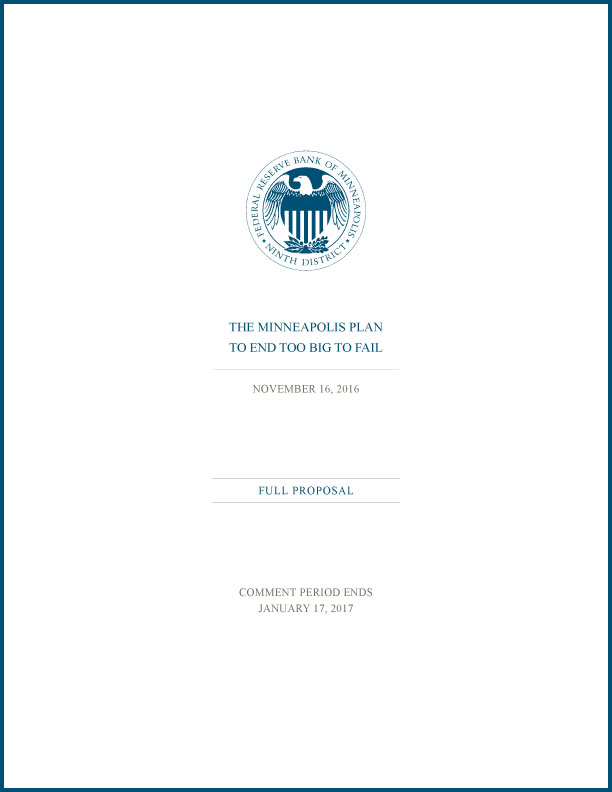This is the November 2016 draft of The Minneapolis Plan to End Too Big to Fail. See the final Plan here.
Plan Contents
- Section 1: Summary of the Minneapolis Plan to End Too Big To Fail
- Section 2: Recommendations: Key Support and Motivation
- Section 3: General Empirical Approach for the Capital and Leverage Tax Recommendations
- Section 4. Technical Calculations Supporting the Capital and Leverage Tax Recommendations
- Section 5: The Banking and Financial System Post-Proposal Implementation
- Section 6: Request for Comments on the Minneapolis Plan to End Too Big to Fail
- Appendix: Ending TBTF Initiative Process
- Key Questions about the Minneapolis Plan to End Too Big to Fail
The Federal Reserve Bank of Minneapolis has engaged throughout 2016 in a public process to determine the best ways to end the problem of too big to fail banks. We solicited feedback throughout the year, held town halls with the public and held four policy symposiums, which brought together experts with a wide range of perspectives on the problem and on potential solutions. The symposiums were streamed live on the web to allow the public to learn alongside the Minneapolis Fed. Video recordings and all presented materials are available on our website at minneapolisfed.org. Input from the public and experts around the world have shaped our effort.
Today, November 16, we released our proposal to end TBTF: the Minneapolis Plan. And as a continuation of our effort to both inform and learn from the public and experts, we continue to seek input. Specifically, the Federal Reserve Bank of Minneapolis seeks comments on its proposal to end TBTF.
Commenters should provide feedback by January 17, 2017, sixty days after the issuance of the proposal. Comments should be submitted via The comment period is now closed. Specific comments will not be made public, but the Minneapolis Fed will publish an aggregated summary of the comments when a revised version of the proposal is released.
The Federal Reserve Bank of Minneapolis welcomes feedback on all aspects of the Minneapolis Plan. Commenters can also provide feedback on the following specific questions:
- Benefit and Cost Analysis of Higher Minimum Equity Requirement
The Minneapolis Plan would increase the minimum equity requirement for banks with assets over $250 billion, reflecting an underlying analysis of the benefits and costs of higher capital.
(Q1) Are there improvements that the Federal Reserve Bank of Minneapolis could make to its calculation of the benefits of this aspect of the proposal?
(Q2) Are there improvements that the Federal Reserve Bank of Minneapolis could make to its calculation of the costs of this aspect of the proposal?
(Q3) Are there improvements that the Federal Reserve Bank of Minneapolis could make to its proposed minimum equity requirement for large banks? - Benefit and Cost Analysis of a “Systemic Risk Capital Charge”
The proposal would create a Systemic Risk Capital Charge for all firms that the Financial Stability Oversight Council fails to certify as no longer systemically important.
(Q4) Are there improvements that the Federal Reserve Bank of Minneapolis could make to its calculation of the benefits of this aspect of the proposal?
(Q5) Are there improvements that the Federal Reserve Bank of Minneapolis could make to its calculation of the costs of this aspect of the proposal?
(Q6) Are there improvements that the Federal Reserve Bank of Minneapolis could make to its proposal calling on the Treasury Secretary to certify that firms are no longer systemically important?
(Q7) Are there alternative frameworks the Federal Reserve Bank of Minneapolis could use in reducing systemic risk of large financial firms? - Setting a Shadow Bank Tax
The proposal would levy a tax on shadow banks.
(Q8) Are there improvements that the Federal Reserve Bank of Minneapolis could make to setting a tax on shadow banks within the framework set forth in the proposal?
(Q9) Are there alternative frameworks the Federal Reserve Bank of Minneapolis could use in setting a tax on shadow banks? What are they? How would a fee be calculated using these alternative frameworks? Why are they superior to the framework used in the proposal? - Right Sizing Community Bank Supervision and Regulation
The proposal would create a separate and more appropriate supervisory and regulatory regime for community banks.
(Q10) Are there specific features of such a regime that the current proposal should include but does not?
(Q11) Are there specific features of such a regime that the current proposal includes that it should not?


